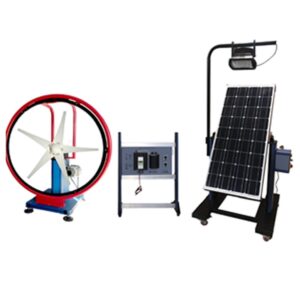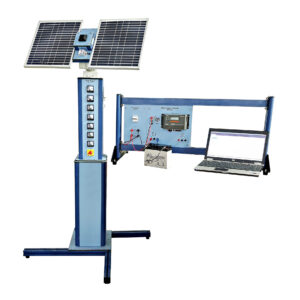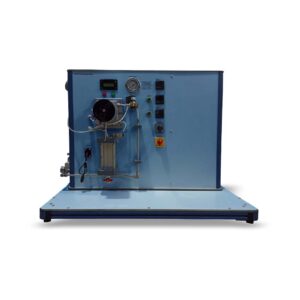Anaerobic digestion (also known as methane fermentation) is a biological process that takes place naturally. In this process, certain microorganisms break biodegradable material in the absence of oxygen. Biogas obtained in this process is a new energy source used as a useful means of decontamination and as an alternate source of renewable energy. Biogas generation through anaerobic breakdown is considered useful when treating biodegradable residues since it generates valuable fuel, as well as an effluent that can be applied as a soil conditioning substance or generic fertilizer. This gas can be used to generate electrical energy by means of turbines or power plants working with gas, in ovens, heaters, driers, boilers, or other combustion systems working with gas, properly adapted to such applications. The Biogas Process Trainer is designed to study and understand the different processes given during the biogas generation through anaerobic breakdown, as well as the study of the different parameters that affect the anaerobic digestion itself and the value of the obtained biogas. The Biogas Process Trainer is supplied with two packed anaerobic digesters. In this way, the user can work either in only one stage or in two stages, separating the different phases of the digestion process (the processes of hydrolysis, acidogenesis, and acetogenesis would take place in the first digester, and the methanogenesis in the second digester). Both digesters have a heating blanket that allows for regulating both the appropriate temperature for each part of the process and the operation with different ranges depending on the used microorganisms. Thus, it can operate at the psychrophilic range (room temperature), mesophilic range (temperatures around 35oC), or thermophilic range (temperatures around 55oC). The unit has four peristaltic pumps which enable the propelling of both the supply to be introduced in the digester and the acid and the base (introduced in two vessels located at the front side) in order to adjust and control thoroughly the pH in each stage of the process. In the case of working in anaerobic digestion in two stages, one of the pumps carries the product from one of the digesters to the other, passing through a buffer tank that collects the excess of flow from the first reactor. The control of these pumps allows for knowing the different flows with which the unit is working. Two volumetric tanks are also included for the storage and volume measurement of the generated biogas. The generated biogas flows through a pipe from the upper side of the digesters to these tanks, where the biogas volume is measured by means of a water displacement. Such tanks have two parts: the upper side is where the generated biogas is collected and the second part, smaller than the first one and located below it, is used to collect the displaced water. Each digester has a temperature sensor and a pH meter. Their function is to follow the whole process and study the influence of the different controlling parameters in anaerobic digestion. Finally, the volumetric tanks, by their upper side, enable the flowing of the collected biogas through a pipe and its passing through a methane (CH4) sensor and CO2 sensor. This sensor allows knowing the methane and carbon dioxide concentration in such current. This way, the biogas quality depending on the physical-chemical conditions under which the anaerobic digestion is developed can be determined, as well as its value as a renewable energy source. The unit is supplied with suitable sensors and instrumentation for the most representative parameters measurements and controls (electronic console).
Experiments
- Study of the stabilization process.
- Study of the effect of temperature on the anaerobic digestion, purification, and quality of the obtained biogas
- Study of the pH effect of the feeding wastewater in the anaerobic digestion, purification, and quality of the obtained biogas.
- Study of the influence of the feeding rate in the anaerobic digestion, purification, and quality of the obtained biogas.
- Study of the inhibitor’s influence on the anaerobic digestion, purification, and quality of the obtained
biogas. - Comparison between the mesophilic and thermophilic anaerobic digestion and their influence in the biogas obtention.
- Determination of the optimum operating temperature.
- Determination of the optimum feeding rate.
- Determination of the optimum solids/water.
- Study of the influence of the type of feeding wastewater in the anaerobic digestion, purification, and quality of the obtained biogas.
- Study of the concentration of nutrients influence of the feeding wastewater in the anaerobic digestion, purification, and quality of the obtained biogas.
- Study of the hydraulic load effect in the anaerobic digestion, purification, and quality of the obtained biogas relation.
- Determination of the optimum degradable/non-degradable solids relation.
- Determination of the multistage nature of anaerobic digestion.
- Determination of the kinetics.
- Carbon balance.
- Solids balance.
- Biogas balance
Specifications
- Anodized aluminum structure and panels in painted steel and HDF.
- Main metallic elements in stainless steel.
- Packed anaerobic digesters of 7.5L capacity each.
- Methane (CH4) sensor to measure its concentration in the generated biogas, 0~100%.
- Carbon dioxide (CO2) sensor to measure its concentration in the generated biogas, 0~100%.
- 2pH meters, range: 0~14.
- Temperature sensors, “K” type.
- Industrial grade CO2, CH4 sensors
Reactors packing:
- 25mm diameter back to balls.
- Heating blanket with a thermostat and a temperature probe to control the heating temperature. temperature range: 0~100oC.
- 4 Peristaltic pumps. Feeding flows measurement by the calibration of the pump.
- 2 Volumetric tanks for the storage and volume measurement of the generated biogas.
- Buffer vessel, of 2L capacity.
- 2 high-density polyethylene vessels, of 3L capacity, for the acid and the base
Electronic console:
- Temperature Digital display for the temperature sensors.
- Pumps switches.
- Pumps controllers.
- Heating blankets switches.
- Cables and Accessories, for normal operation.




